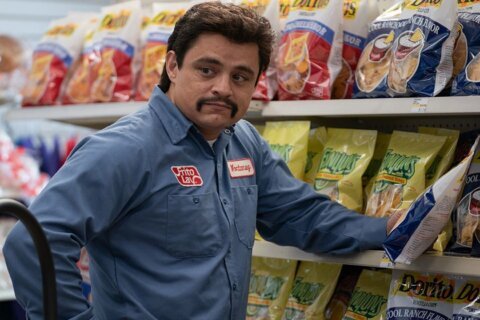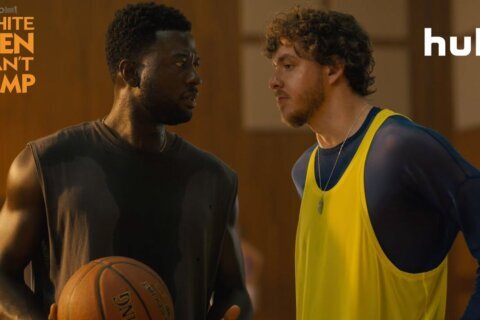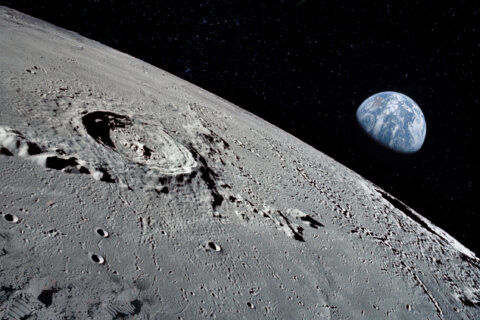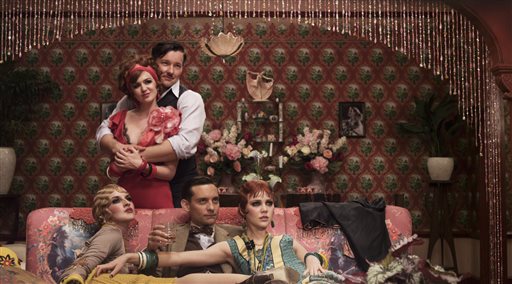
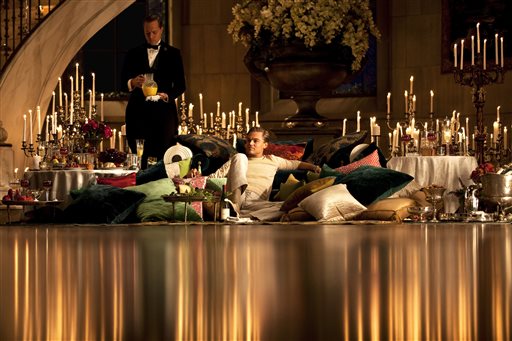
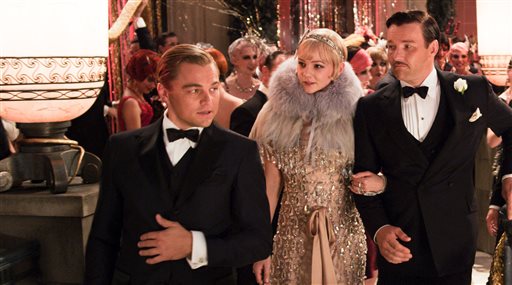
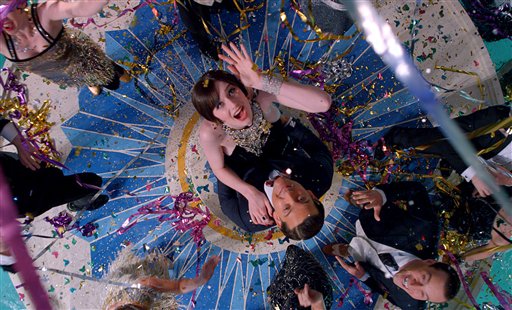
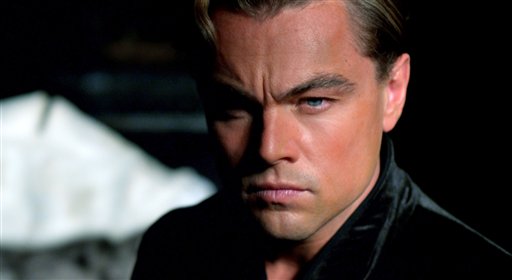
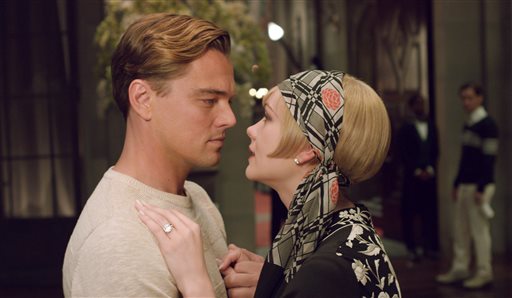
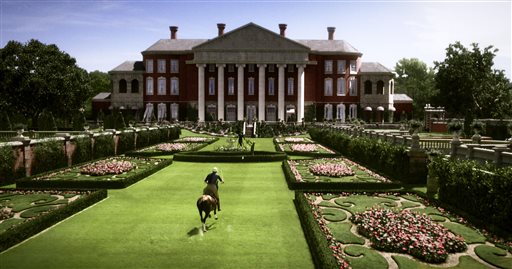
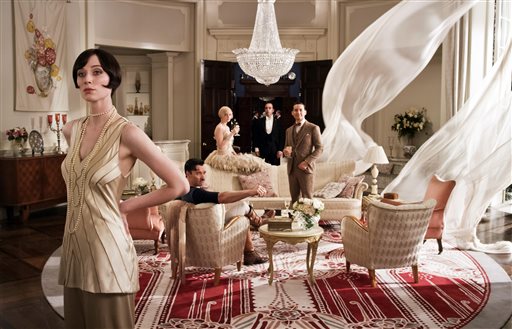
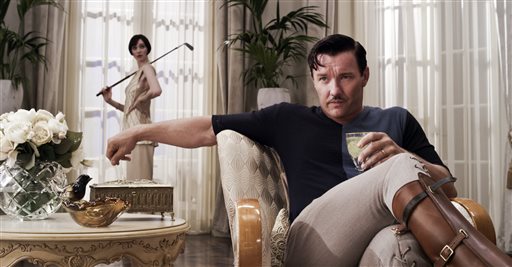
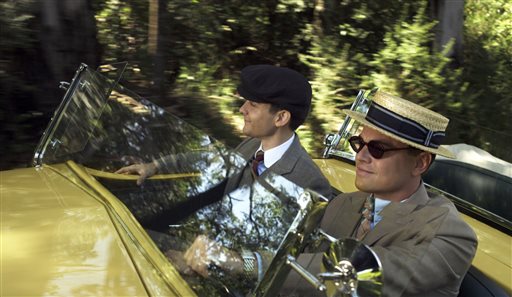
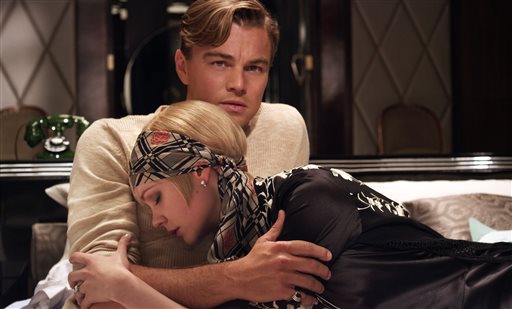
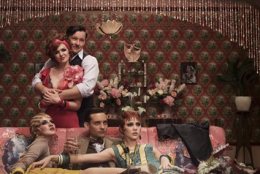

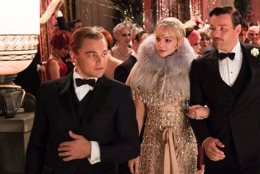
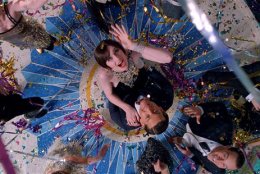
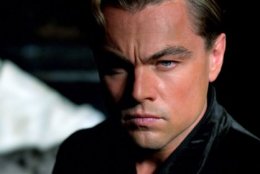
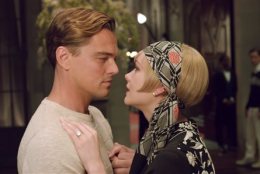


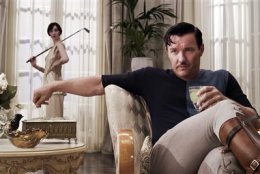
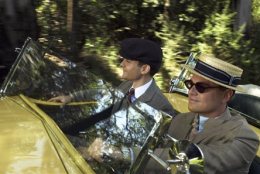
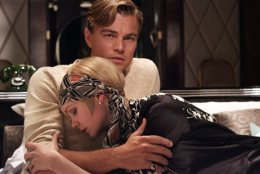
Jason Fraley, WTOP film critic
WASHINGTON – “Do you think it’s too much?”
“I think it’s what you want.”
Don’t believe the majority of babyboomer critics on this one. Baz Luhrmann’s “The Great Gatsby” is a solid adaptation.
Either you like Luhrmann’s style or you don’t, and it may be generational. So, ladies and gentlemen of the Class of 2013, if you burn easily, it’s time to don some 3D sunglasses and wear sunscreen to “Gatsby,” albeit a slightly lower SPF than “Moulin Rouge,” and spray it on like Old Spice, old sport.
If you agreed that “Rouge” was one of the AFI’s Top 25 Musicals, you may love “Gatsby.” If you couldn’t stand the time- bending razzle dazzle, maybe stay away from this one. But love it or hate it, there’s a certain bittersweet parallel between Luhrmann and Gatsby, hosting lavish parties to impress countless invitees (except the ones they desire most), desperately reaching for the flashing light of Oscar statues and Daisy hearts, always just beyond their reach.
Based on F. Scott Fitzgerald’s classic American novel — perhaps the most American of novels — the plot comes straight from your high school reading list. Narrator Nick Carroway (Tobey Maguire) recounts his friendship with Jay Gatsby (Leonardo DiCaprio), a mysterious millionaire living in a mansion outside New York City circa 1922. His parties are the talk of the town, but are meant to lure his long- lost love Daisy (Carey Mulligan).
There’s just one problem: Daisy has since married the brute Tom Buchanan (Joel Edgerton) whose mistress Myrtle (Isla Fisher) lives with her husband George Wilson (Jason Clarke) under the watchful eyes of an omniscient billboard in the “Valley of Ashes.”
Written in 1925 at the height of the Roaring Twenties, Fitzgerald knew this decadence was unsustainable. Gatsby’s fall thus tragically predicts the stock market crash of 1929. Surely I’m not alone in saying that Fitzgerald’s masterpiece is one of my favorite books. Perhaps it’s because the author is buried right here in Rockville, Md., or because he took the “F. Scott” from Maryland native Francis Scott Key. Or, maybe, there’s just something so beautifully tragic about a man who moves across the river from “the girl that got away.” Give it another read as an adult. It’ll knock you out.
No one’s been able to truly capture the book’s complexity on film, though many have tried.
The first attempt came just a year after the book’s release with “The Great Gatsby” (1926), starring Warner Baxter (“42nd Street”) as Gatsby and William Powell (“The Thin Man”) as George Wilson. Sadly, this film is lost to history, like many criminally unpreserved silent films.
The next notable attempt came in 1949, directed by Elliot Nugent and starring Alan Ladd as Gatsby, four years before his career role in “Shane” (1953), and Shelly Winters as Myrtle, two years before her love triangle in “A Place in the Sun” (1951).
Most people remember the 1974 version, starring Robert Redford, Mia Farrow and Bruce Dern, written by Francis Ford Coppola the same year he wrote and directed “The Conversation” (1974) and “The Godfather: Part II” (1974). “Gatsby” seems small by comparison, living alone like Hackman, but lacking Pacino’s ability to see the killer lurking behind blowing curtains. Frankly, I’m surprised at the number of folks holding up this “Gatsby” as an untouchable classic. Even Coppola couldn’t save the lack of chemistry between Redford and Farrow and the lack of imagination by director Jack Clayton.
“You can’t repeat the past? Of course you can!” And so, we get the latest adaptation, co-written by Luhrmann and Craig Pearce, collaborators on the loosely- tied “Red Curtain Trilogy” of “Strictly Ballroom” (1992), “Romeo + Juliet” (1996) and “Moulin Rouge!” (2001).
To cast his lead, Luhrmann turned to the rising star he helped launch in “Romeo + Juliet” (1996), transitioning Leo from a Best Supporting Actor nomination for “What’s Eating Gilbert Grape?” (1993) to an iconic leading role in “Titanic” (1997). Still, the direction of DiCaprio’s career could have gone to trash, if not for Martin Scorsese, who hand-picked him as his new DeNiro, casting him in “Gangs of New York” (2002), “The Aviator” (2004), “The Departed” (2006) and “Shutter Island” (2010). Three Oscar nominations later, DiCaprio has silenced the doubters, courting such talented directors as Spielberg (“Catch Me If You Can”), Zwick (“Blood Diamond”), Mendes (“Revolutionary Road”), Scott (“Body of Lies”), Nolan (“Inception”), Eastwood (“J. Edgar”) and Tarantino (“Django: Unchained”).
His performance as Gatsby is one of his best yet. While Redford looked the part, he never quite captured the nervousness of a freshly-made fortune. DiCaprio does both, breaking hearts in dapper fashion while maintaining Jack Dawson’s “I don’t belong here” vibe beneath the surface.
Could this be DiCaprio’s Anne Hathaway Oscar moment – a stellar performance in an overblown adaptation of famous source material? Maybe not, but actors often win for less deserving roles: Bogie’s “African Queen,” Newman’s “The Color of Money” and Pacino’s “Scent of a Woman.”
While Leo is inspired casting as Gatsby, Luhrmann dropped the ball casting Tobey Maguire (“Spider-Man”) in the role of Nick. His meek, dry reading is an awkward vessel as our narrator, no worse than Costner in “Dances with Wolves,” but keeping the film from soaring with a Morgan Freeman eloquence. The role would have been better suited for a Joseph Gordon-Levitt, who was a DiCaprio sidekick in “Inception;” Jake Gyllenhaal, whose “Brokeback” memories would have played up the homoerotic subtext; or Ryan Gosling, who demonstrated a ready chemistry with Mulligan in “Drive.”
Mulligan, an Oscar nominee in “An Education” (2009), is a fine Daisy, playing the role with all the breathless beauty of Michelle Williams in “My Week with Marilyn” (2011). I often think of both actresses as modern-day Mia Farrows, making the Daisy part a close fit. She was originally supposed to pair with Ben Affleck, but when he dropped out over a scheduling conflict, the role of Tom Buchanan went to Joel Edgerton, the squadron leader in “Zero Dark Thirty.”
His “Zero Dark” co-star Jason Clarke plays the trashy gas-station attendant George Wilson, who pairs with “Wedding Crashers” stage-five clinger Isla Fisher as Myrtle. You may not even recognize her, due to her lack of screen time. We can’t mourn her, because we hardly know her.
Still, the biggest “star” is Luhrmann, thrust into the spotlight by his own accord with an “amusement park” showmanship. He may have sounded like an odd choice for this novel, but his filmography is full of flashy period tales ending in tragic love stories. The word “auteur” gets thrown around way too much, but Luhrmann is one of the few current directors with a distinctly recognizable authorship, somewhere between the waterfalls of Busby Berkeley and the glitter of Dusan Makavejev.
I suppose not all auteurs are created equal. Luhrmann’s premature claim to the title feels cheap compared to a prolific filmmaker like Howard Hawks, who mastered multiple genres. Still, Luhrmann feels similar to the lead character in “Strictly Ballroom,” a performer who refuses to follow the accepted rules of his craft, infuriating the art establishment by creating his own style.
Gone is the red curtain, but the Luhrmann staples abound: Oscar-caliber costumes by his wife and collaborator Catherine Martin, smash zooms from extreme wide-shots to extreme closeups (like the aerial flip in “Moulin Rouge”), typewriter text that appears on the screen, montages of superimposed images, archival footage, slow-motion action sequences, “Citizen Kane” transitions from newspaper photos to moving reality, “Rear Window” voyeurism from New York apartments and an underwater “Sunset Blvd” shot in a swimming pool, set up as Nick asks Gatsby, “Are you ready for your closeup?”
The biggest Luhrmann staple will turn off many critics: The desire to drop modern pop music into a period piece. The soundtrack mixes the vintage music of Cole Porter and George Gershwin with the modern tracks of Jay-Z, Beyonce, Amy Winehouse, Lana Del Rey, Kanye West, will.i.am, Florence + The Machine and Jack White, whose “Love is Blindness” cover may just become a hit.
Those at all shocked by this don’t know Baz Luhrmann. “Romeo + Juliet” spawned a massive radio hit in The Cardigans’ “Lovefool,” while “Moulin Rouge” inspired a “Lady Marmalade” remake with Christina Aguilera, Pink, Mya and Lil’ Kim. You know what you’re getting with Luhrmann, and baby boom critics can’t in one breath pan “Gatsby” for out-of-time music in 1922 New York, while hailing “Moulin Rouge” for dropping The Beatles, Kiss, Phil Collins, Joe Cocker and David Bowie into Paris in 1900. While I like classic rock more than today’s stuff, I’m sensing a bit of a double standard here.
Between the brash soundtrack and flashy visuals, you’ll understand Nick’s reaction as he crosses the bridge into New York City: “I was overwhelmed, but I felt like anything could happen.”
This “Come What May” motto was a hit song in “Rouge,” but it brings plenty of excess in “Gatsby,” causing us to feel “at once within and without,” as Nick says of his dazzling new environment.
Thankfully, there are more moments “within” than “without.” A number of Luhrmann’s directing choices are deliciously creative, particularly his stylized character introductions.
While Nugent used a wide single-take to introduce Daisy in 1949, and Clayton used a straightforward pan to introduce her in 1974, Luhrmann dollies through hypnotic silk curtains to find her looking seductively up from a couch like Marilyn Monroe in “The Asphalt Jungle” (1950).
As for Gatsby’s introduction, Nugent reveals him in a standard medium two-shot, and Clayton uses a routine cut. Luhrmann instead follows a faceless DiCaprio, who eventually turns around to the backdrop of fireworks and Gershwin’s “Rhapsody in Blue” like Woody Allen’s “Manhattan” (1979).
Luhrmann also ups the ante in depicting Myrtle’s car crash. The 1949 film cross- cuts the crash in a dated special effect collision, showing right away that it’s Daisy driving with Gatsby in the passenger seat, missing an opportunity for the mystery of the driver. The 1974 version admirably keeps the mystery of the driver, but does so by avoiding the scene entirely, only showing the aftermath. Now, Luhrmann takes the best of both, showing the suspense of the crash in slow-motion horror, while maintaining the mystery of the driver by controlling what we see.
This is what directors should do, hover over their films as the omniscient master of their characters’ fate, the “eyes of God” watching from the dentist billboard, as fatalistic bifocals dissolve into car headlights just before the crash. Luhrmann revels in such symbols: the billboard, the yellow and blue automobiles, the Gatsby mansion, the green blinking light.
It’s hard to go too far off the rails with a story this true. It may not be a “great” Gatsby, but it’s at least a good Gatsby, arguably better than the mediocre versions that preceded it and worth seeing if only to rediscover this powerful novel. As of 9 a.m. Friday, “Gatsby” was the top-selling iBook.
Nick’s reaction to Gatsby the man echoes my reaction to “Gatsby” the movie, “representing everything for which I have an unaffected scorn (style over substance), but (the film) turned out alright in the end, it’s what preyed on (Luhrmann), what foul dust floated in the wake of his dreams (pomp, circumstance, 3D glasses), that temporarily turned out my interest.”
By the end, Luhrmann is a bloodied Gatsby floating face first in his own pool, suffering the same fate as Joe Gillis and Tony Montana, ready for his closeup, exceeding like excess.
To paraphrase Fitzgerald, Luhrmann’s Gatsby dream seemed so close, but he did not know that it was already behind him. He believed in the flickering projector light, the orgastic film future that year by year recedes before us. It eluded us then, but that’s no matter. Tomorrow we will run faster, stretch out our arms farther, paint our pictures brighter. And so we beat on, Gatsby film after Gatsby film, boats against cinema’s current, borne back ceaselessly into the past.
★ ★ ★
The above rating is based on a 4-star scale. Follow WTOP Film Critic Jason Fraley on Twitter @AboveTheJFray or on his blog The Film Spectrum.


